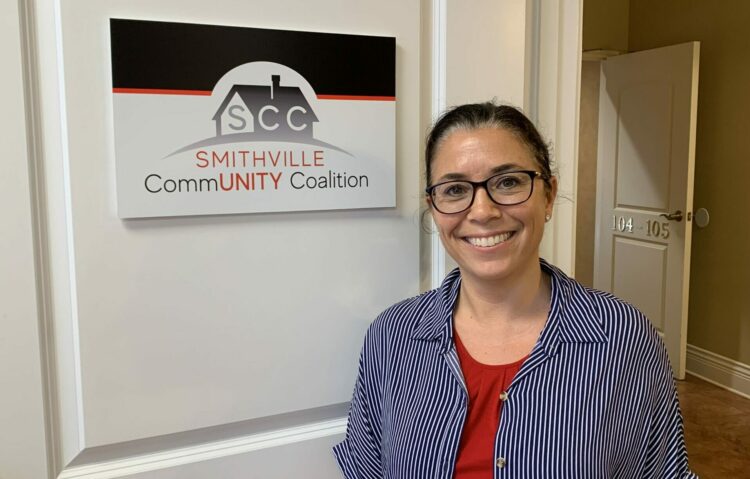
Dawne Kakitsis at the entrance to the Smithville CommUNITY Coalition office on Catawba Avenue.
March 30. By TL Bernthal. Before funding came through in December to pay for staff and an office lease for the Smithville CommUNITY Coalition, work was done in a smaller space downtown that accommodated a desk and four chairs.
Dawne Kakitsis, director of fundraising and marketing, says staying near and accessible to the Smithville neighborhood was an important consideration when the agency decided on its new home at 21031 Catawba Ave., near the Cornelius Library branch.
The Smithville CommUNITY Coalition plans an open house in late April once signage is up and staff is settled, Kakitsis says.
Willie Jones is the group’s executive director; Lisa Mathew-Jones is project manager / residential services; Morgan L. Hinton is finance and administration manager; and Kakitsis is director of fundraising and marketing.
The group is the force behind the Smithville Revitalization Plan. Through the plan, organizers hope to retain as many existing and historic structures as possible, get sidewalks and wider streets, fix sewer-water issues and at the same time provide workforce housing that also allows current residents to stay in their homes. Mecklenburg committed $3 million in funding, and Cornelius set aside $3 million for the plan from the 2023 budget.
The coalition purchased homes to provide temporary relocation housing for Smithville residents who cannot stay in their homes as upgrades are under way, Kakitsis says.
Those projects could include lead pipe and paint remediation.
Beginning last year, the coalition has bought three homes in the Smithville neighborhood for a total of $358,500. The homes, according to the Mecklenburg County register of deeds, that the Smithville CommUNITY Coalition purchased:
• 19309 South Hill St. on Nov. 29 for $160,000.
• 19626 South Hill St. on Jan. 12 for $118,500.
• 19629 South Hill St. on Jan. 18 for $80,000.
A look back, and ahead
The Smithville community was originally formed by freed enslaved people from many of the region’s cotton plantations. The land was made available by the descendent of the Potts Plantation in the late 19th century.
Smithville wasn’t part of the town until Cornelius annexed the neighborhood in 1972.
Sometime soon, Kakitsis says a sign will go up at the Catawba Avenue / US 21 intersection proclaiming: Welcome to Historic Smithville.
Before the community was incorporated, the residents didn’t have the benefits available to white residents. Still, Smithville residents built a thriving community that provided workforce housing to many African Americans, according to a written historic overview.
Importance
Historic architectural features include a Rosenwald School, now privately owned, and many examples of architecture prevalent in workforce housing throughout the 20th century.
Historically African American communities are rapidly disappearing throughout the South in urban and suburban settings, according to the overview.
The revitalization plan — through preservation easements, restoration and rehabilitation on select historic properties and using new construction for additional affordable housing — offers the opportunity to preserve and revitalize “an exceptional and important African American historic community,” the overview says.
What’s coming next
Jones says the coalition hopes to present re-zoning plans for the Smithville revitalization plan to the town Planning Board this summer and get the board’s OK.
Simultaneously, hundreds of details for home construction, stormwater drainage and more are being weighed and worked out. For example, if the price of wood continues to rise, would home construction materials need to include steel and concrete.
The goal for the single-family homes is to be 1,500 to 1,600 square feet, with the price less than $300,000.
With all the moving parts, there’s no firm timeline, but Jones hopes to have construction begin by the end of the year.




